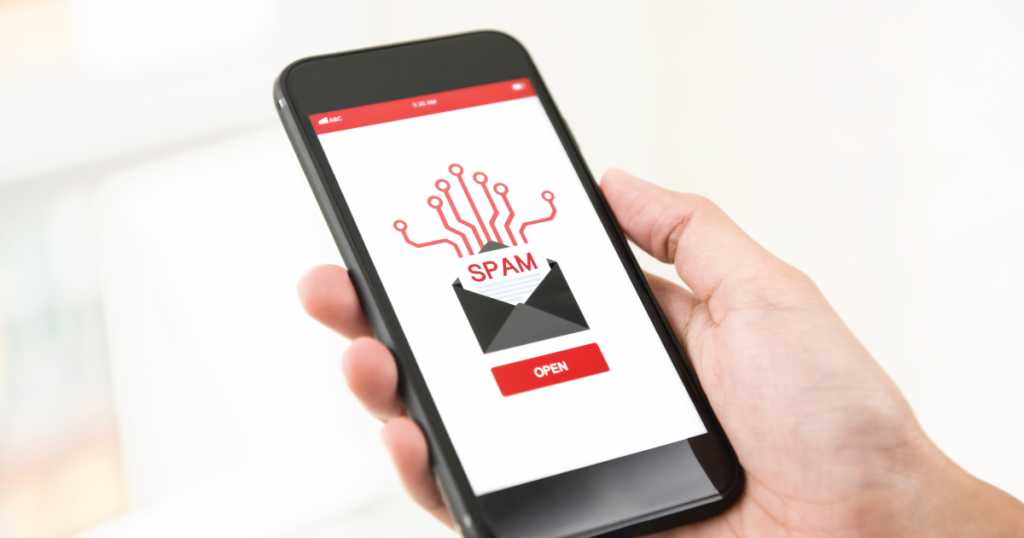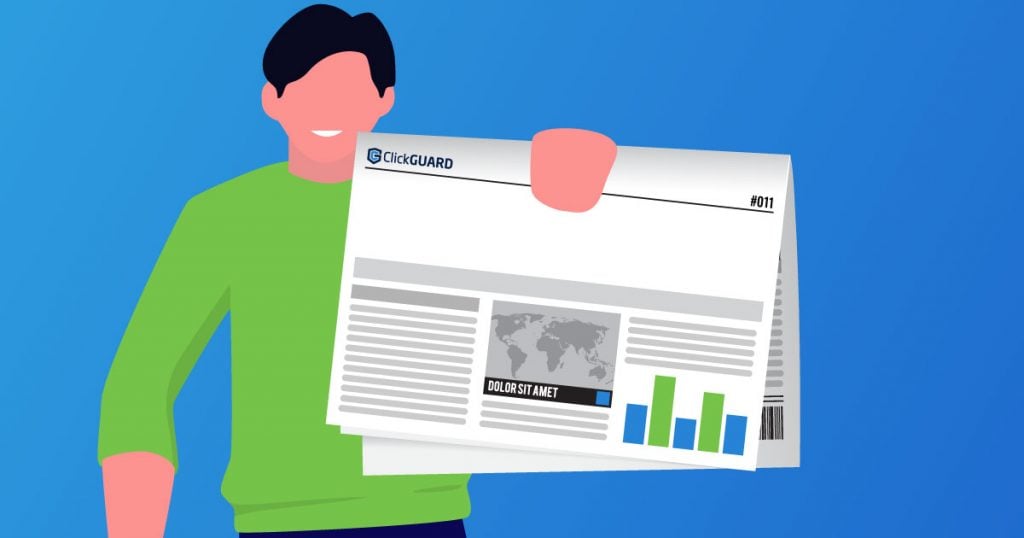Before getting into the click fraud statistics lets take a quick look at what the problem is. What is click fraud anyway?
What is Click Fraud?
Click fraud is one of the first things that you need to be cautious of when running a PPC campaign. Click fraud (also known as PPC fraud or ad fraud) refers to invalid or illegitimate clicks on PPC ads that are generated by bots, scripts, humans, or any other way.
The purpose of this type of fraud is to exhaust the budget of the advertisers or to bring more money for websites that host ads. Google is aware of the issue, but they qualify both fraudulent clicks and unintentional clicks as “click fraud”. Clearly, this is a problem, because unintentional clicks are not necessarily click fraud, and fraudulent clicks are definitely not unintentional in nature.

PPC fraud has existed for years and has its roots in early PPC and advertising networks. Publishers used to click ads on their own websites to earn money and this practice of earning money has transformed into a gigantic industry today.
PPC fraud isn’t new. It has been around since the early days of PPC and advertising networks, when publishers used to click ads on their own websites to drive more revenue. Yet, today, click fraud is a multi-billion dollar problem that needs to be stopped.
Wondering just how big of an issue it is?
Read on and find out more.
Click Fraud, PPC Fraud, and Click Fraud Statistics
Here is an overview of the leading PPC fraud statistics:
- Almost half of all internet traffic is generated by bots. (ClickGUARD, 2020)
- One out of every three dollars spent by advertisers is wasted due to ad fraud. (Media Post, 2019)
- Ad fraud or click fraud is stealing $66 bilion in global online ad spending which is almost 20% (Campaign Asia, 2020)
- 14% of all PPC clicks are estimated to be click fraud. (ClickGUARD, 2020)
- Almost 56% of all online ads are never seen by any human. (AdAge, 2014)
- Global businesses are expected to lose $44 billion by 2022 due to ad fraud. (ClickGUARD, 2020)
Global businesses are expected to lose $44 billion by 2022 due to ad fraud. (ClickGUARD, 2020)
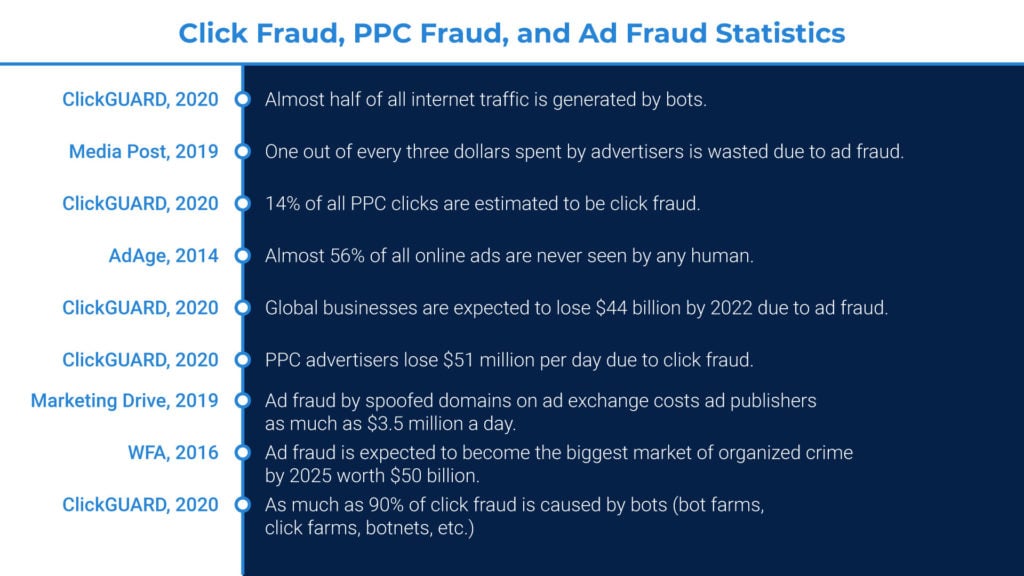
- PPC advertisers lose $51 million per day due to click fraud. (ClickGUARD, 2020)
- Ad fraud by spoofed domains on ad exchange costs ad publishers as much as $3.5 million a day. (Marketing Drive, 2019)
- Ad fraud is expected to become the biggest market of organized crime by 2025 worth $50 billion. (WFA, 2016)
- As much as 90% of click fraud is caused by bots (bot farms, click farms, botnets, etc.). (ClickGUARD, 2020)
- 77% of all US fraudulent traffic is categorized as sophisticated invalid traffic. (Marketing Drive, 2019)
- 54% of ad fraud in the US is carried on desktops while 46% is done on mobile. (Marketing Drive, 2019)
- The highest fraud rate was reported in North America, at 2.1%, followed by the EMEA region, whose fraud rate stood at 2%. (Statista, 2020)
- The global estimated cost of invalid clicks is $23 billion in 2020. (University of Baltimore, 2019)
As you can see so far the click fraud statistics are just staggering, and they just keep getting bigger.
The total cost of invalid clicks in the US is predicted to be $9 billion in 2020. (University of Baltimore, 2019)
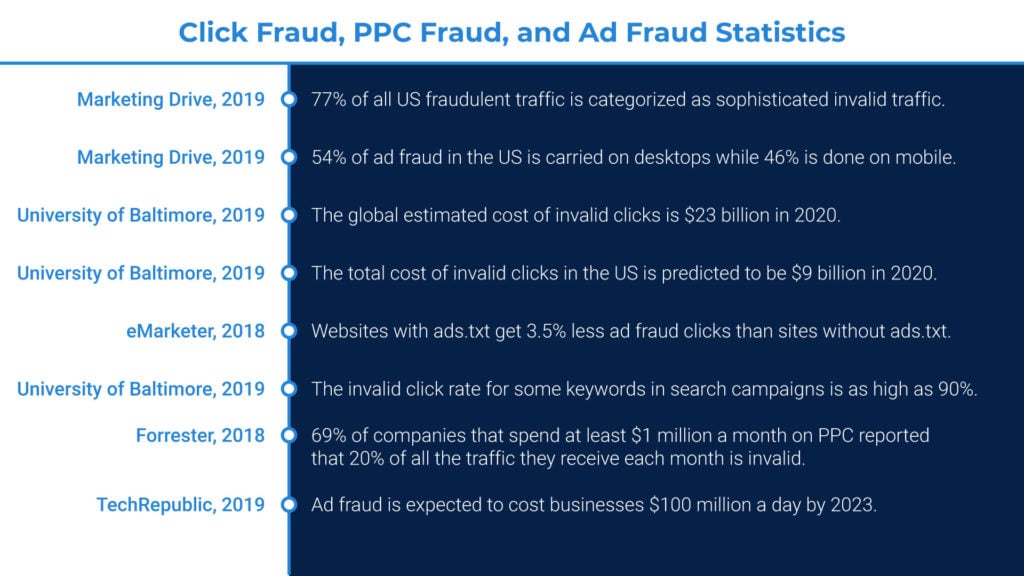
- Websites with ads.txt get 3.5% less ad fraud clicks than sites without ads.txt. (eMarketer, 2018)
- The invalid click rate for some keywords in search campaigns is as high as 90%. (University of Baltimore, 2019)
- 69% of companies that spend at least $1 million a month on PPC reported that 20% of all the traffic they receive each month is invalid. (Forrester, 2018)
- Ad fraud is expected to cost businesses $100 million a day by 2023. (TechRepublic, 2019)
- One in five of all US programmatic ads in 2019 had invalid traffic. (ClickGUARD, 2020)
- 36% of businesses don’t know how much they’re exposed to ad fraud. (WFA, 2020)
- 88% of digital ad clicks are fraudulent. (Oxford Biochronometrics)
- Mobile ad fraud resulted in a $1.6 billion loss in the first quarter of 2020. (AppsFlyer, 2020)
- Attribution is one of the biggest ad fraud sources in 2020. (Media Post, 2019)
- The global fraud detection and prevention market is expected to be an $85 billion market by 2025. (VynZ Research, 2020)
- USA, APAC, and the Middle East are the top-ranked locations for web fraud. (Fraud Score, 2020)
- Russia, APAC, and CIS are the top-ranked locations in terms of mobile fraud. (Fraud Score, 2020)
These click fraud statistics show how huge this market is and where it is heading. PPC fraud is linked to PPC spending, and it grows with the same proportion. When advertisers spend more on PPC, fraudsters earn more because a certain percentage of clicks in any PPC campaign turns out to be fraudulent.
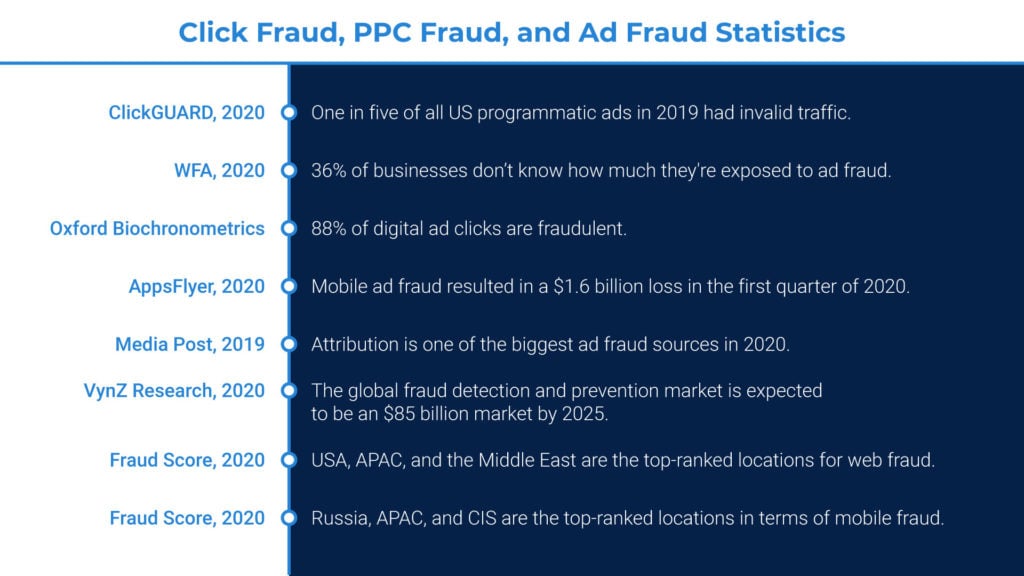
Industry Click Fraud Statistics
Industry Click Fraud Statistics
Here is an overview of the click fraud statistics for specific industries that shows how it impacts leading markets in the world. A click fraud protection tool is a must in today’s time, and the following numbers show it clearly.
To put numbers on just how big the issue of click fraud is, we dove deep into the data at ClickGUARD and determined that 17% of Google Ads traffic is fraudulent. To calculate how much money some of the highest-spending industries are losing, we looked at how much these industries are spending on digital advertising and applied the Google having revenue share in the ad industry of 28.9% on those numbers. The result was the amount of money each of these selected industries spent on Google Ads.
Here are the results:
B2B Industry
The B2B industry spend a whooping $8.68 billion on digital advertising in 2020. If we apply the 28.9% Google revenue share on this number, it means that this industry spent more than $2.5 billion on Google Ads in 2020 With Google having revenue share in the ad industry at 28.9% in 2020, one can determine that the B2B industry spent $2.508 billion on Google Ads.
Furthermore, applying the 17% click fraud rate we determined from our data, all this means that the B2B industry has lost approximately $0.42 billion to fraudulent clicks.
Consumer Services
The business services industry in the U.S. spent about $15.64 billion on digital advertising in 2020. Applying the same data points as above, we can determine that the Consumer Services industry spent $4.519 on Google Ads in 2020 – and lost about $0.768 billion to click fraud.
eCommerce
The ecommerce industry spent $18.72 billion on advertising in 2020. With the Google Ads revenue share at 28.9%, that means the eCommerce industry spent $5.41 billion on Google Ads in 2020. If we apply the 17% click fraud rate we researched to this number, it means the eCommerce industry lost about $0.91 billion to click fraud.
Education
A survey of representatives of the educational services industry found that the sector spent about $1.6 billion on advertising in 2020. Applying the same data points as we did for the other industries, that means that the Education sector spent about $0.91 billion on Google Ads – and lost about $0.078 million.
Finance
Digital advertising spending in the U.S. financial services industry was about $19.62 billion in 2020, including approximately $5.67 billion on Google advertising. According to the click fraud percentage we have found in our internal data, this means that the Financial industry lost up to $0.963 billion to fraudulent clicks in 2020.
Bots Farms Click Fraud Statistics
Bots, bot farms, botnets, click farms, and other scripts are an important element of the click fraud industry. A fairly large number of clicks are carried out via these bots. Here is an overview of the PPC fraud statistics specifically related to bot farms:
- Bots inflate monetized audience by 50%. (White Ops)
- 28% of website traffic is generated by bots. (Adobe, 2018)
- Spam sites sent 10 to 100 times more traffic to advertising exchanges than real sites. (Botlab, 2020)
- PPC agencies and businesses are expected to lose $7.2 billion due to bots by the end of 2020. (ClickGUARD, 2020)
- Methbot was one of the highly sophisticated bot farms with more than 1900 dedicated servers that cost advertisers $3 million per day consistently. (ClickGUARD, 2020)
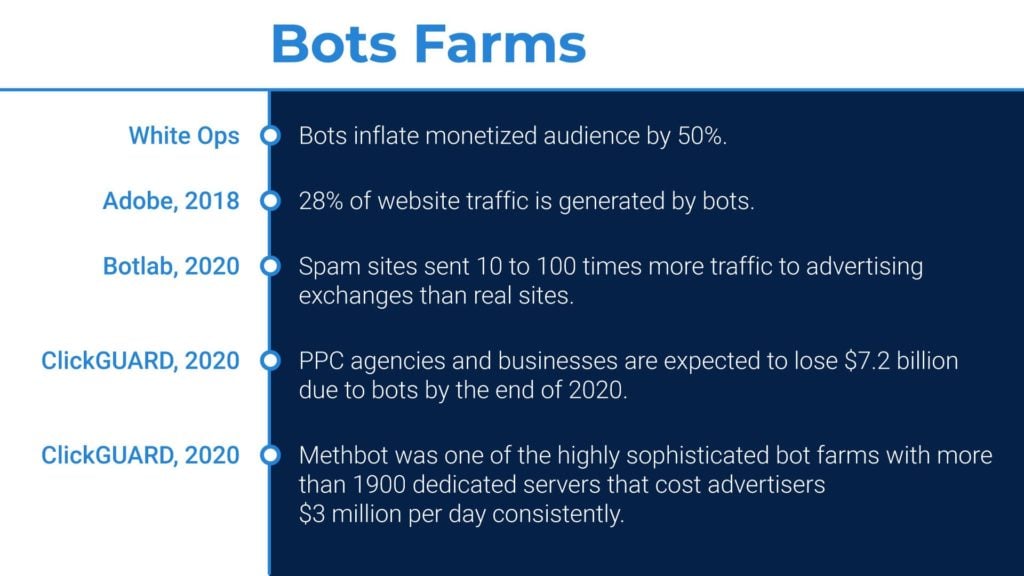
- 3ve is one of the biggest bot farms that’s currently active. It controls more than 1 million IP addresses and over 700,000 devices. Google, along with other partners, is still hunting for 3ve. (ClickGUARD, 2020)
- Hydra is an ad fraud operation that creates fake app traffic and has cost marketers $133 million. Google and other companies are still trying to hunt it down. (Business Insider, 2020)
- Icebucket is a bot network that generated around 1.9 billion ad requests for 300 publishers and impacted 2 million people on the connected TV. (Marketing Drive, 2020)
- Smart bots are the most common ad fraud type that accounts for 57% of mobile ad fraud. (Scalarr, 2020)
- Click spam and smart bots together account for 90% of mobile ad fraud. (Scalarr, 2020)
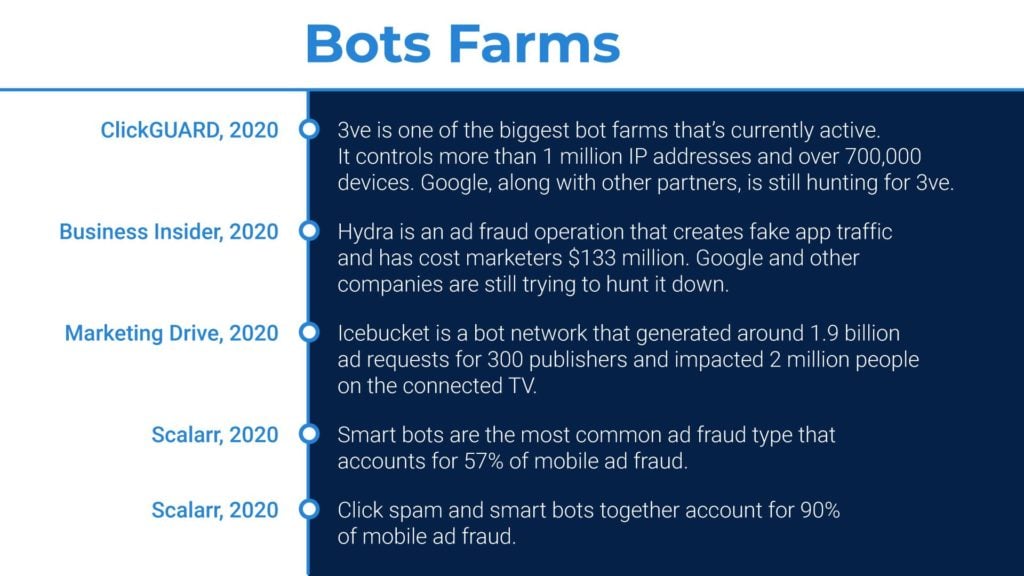
That Wrap
Click fraud isn’t going anywhere anytime soon. The click fraud statistics above clearly show that PPC fraud is a rapidly growing market that is linked to global digital ad spend. As long as businesses are spending money on ads, ad fraud won’t go anywhere – at least not for now.
The ad fraud market is gigantic and it is growing exponentially. How big it will become after a few years and where and how it will end, nobody knows. Ad networks like Google Ads and Facebook are busy tackling and minimizing click fraud but you can’t (and shouldn’t) rely on your ad network.
Your best bet is to take preventive steps to protect your PPC campaigns from all types of fraud. Monitor your ad campaigns constantly and block click fraud automatically with a PPC fraud detection and prevention tool such as ClickGUARD. Spending a few dollars on PPC click fraud protection can help you save millions in the long run.


